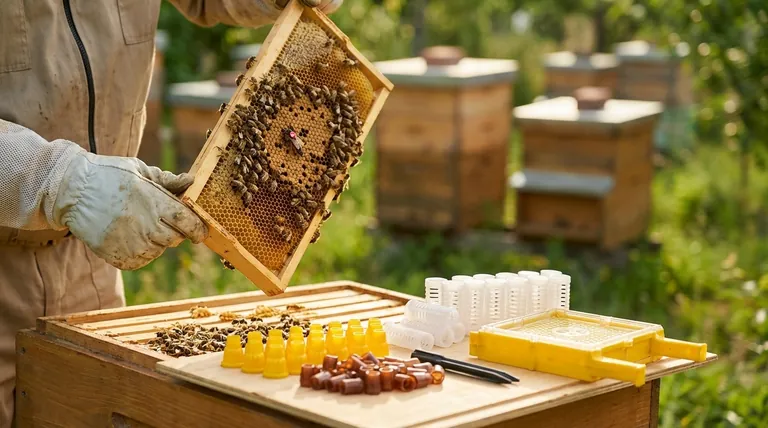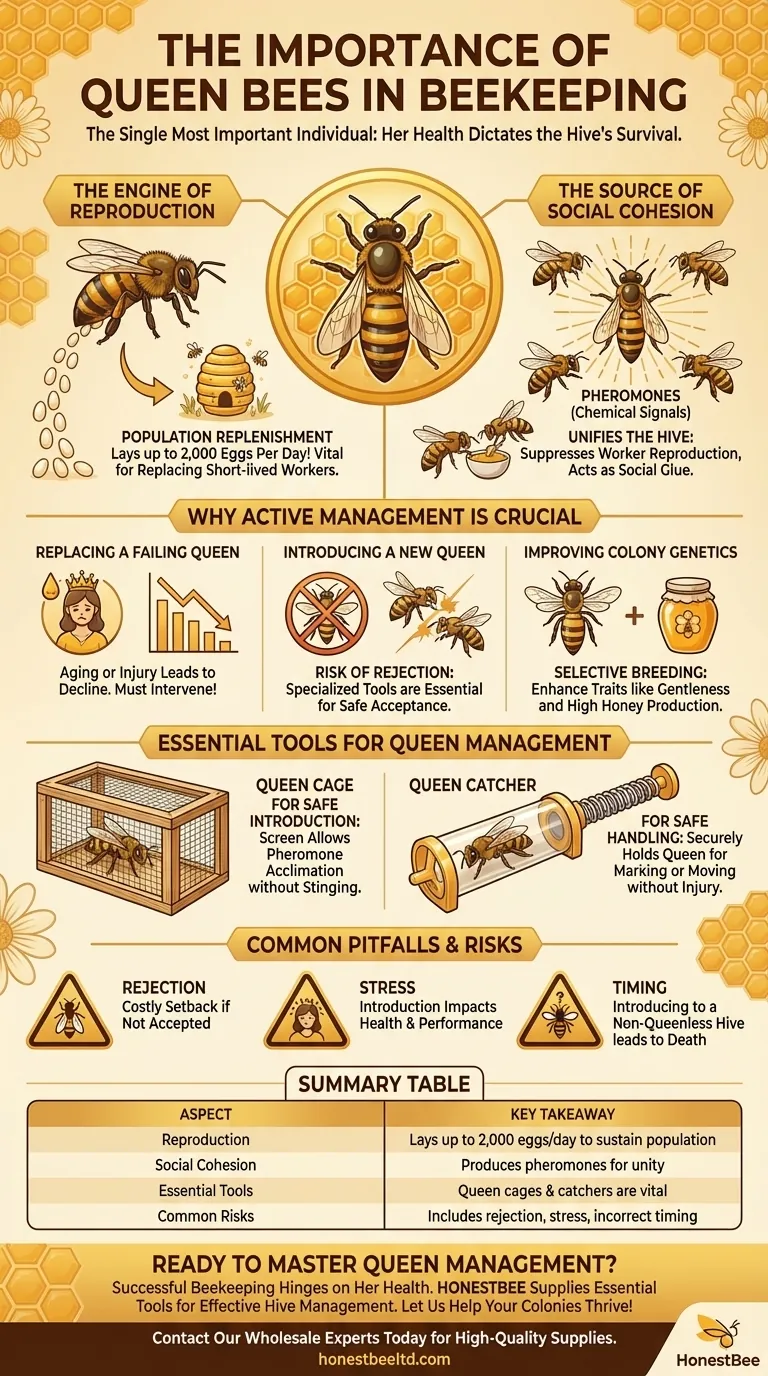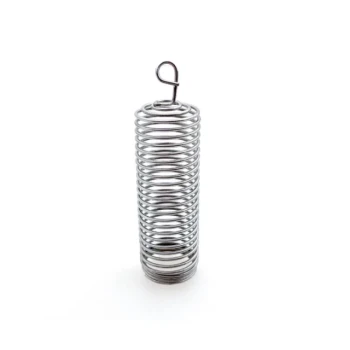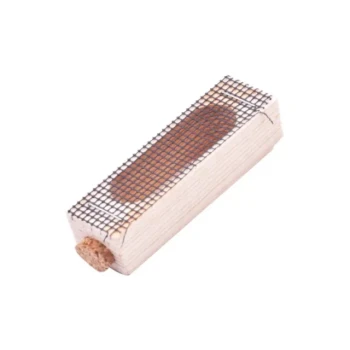At its core, the queen bee is the single most important individual in a honey bee colony. She is the sole reproductive female, responsible for laying up to 2,000 eggs per day to ensure the hive's population is constantly replenished. The queen's health, genetics, and pheromones dictate the colony's productivity, temperament, and very survival.
The success of a honey bee colony is entirely dependent on having a healthy, accepted, and productive queen. Therefore, successful beekeeping is less about managing thousands of bees and more about skillfully managing that one, single bee.

The Queen's Central Role in the Colony
To understand beekeeping, you must first understand the queen's two primary functions. She is not a ruler who gives orders, but rather the biological and chemical heart of the hive.
The Engine of Reproduction
The queen's most critical job is laying eggs. A strong queen can lay her own body weight in eggs each day during peak season.
This constant production is vital for replacing older worker bees, which have a short lifespan of only a few weeks in the summer. Without a steady supply of new bees, the colony's population would collapse.
The Source of Social Cohesion
The queen produces a unique blend of chemicals called pheromones. These pheromones spread throughout the hive as bees groom and feed each other.
This chemical signal communicates to the entire colony that they have a healthy, laying queen. It suppresses the reproductive instincts of worker bees and provides the social "glue" that keeps the tens of thousands of individuals working together as a single organism.
Why Beekeepers Must Actively Manage the Queen
A colony's dependence on a single queen is also its greatest vulnerability. Beekeepers cannot simply install bees and hope for the best; they must actively monitor and manage the queen.
Replacing a Failing Queen
Queens have a limited productive lifespan. If a queen ages, becomes injured, or runs out of stored sperm, her egg-laying rate will decline. The hive will weaken and eventually die if the beekeeper doesn't intervene by replacing her.
Introducing a New Queen
When starting a new hive or replacing a failing queen, you cannot simply drop a new queen into the colony. The worker bees will perceive her as a foreign invader and kill her instantly.
This is where specialized tools and techniques become essential for successful beekeeping.
Improving Colony Genetics
Beekeepers can actively improve the traits of their colonies through a process called queen rearing.
By selectively breeding queens from hives that show desirable traits—such as gentleness, high honey production, or resistance to mites—a beekeeper can significantly improve the health and productivity of their apiary.
Essential Tools for Queen Management
Because the queen is so vital yet so fragile, beekeepers rely on specific tools to handle and introduce her safely.
The Queen Cage: For Safe Introduction
A queen cage is a small box, often made of wood and screen, that protects a new queen when she is first placed in a hive.
The screen allows the worker bees to smell and touch the new queen's antennae, but prevents them from stinging her. Over several days, they gradually acclimate to her pheromones and accept her as their own.
The Queen Catcher: For Safe Handling
A queen catcher or clip is a small, spring-loaded plastic tool used to gently secure a queen during a hive inspection. This allows the beekeeper to safely mark her or move her without risk of injury.
Common Pitfalls and Risks
Managing a queen bee is a delicate process with inherent risks that require care and attention.
The Risk of Rejection
Even with the proper use of a queen cage, there is no guarantee a colony will accept a new queen. If the bees do not accept her after she is released, they will kill her, a costly and time-consuming setback for the beekeeper.
Stress During Introduction
The process of being caged, shipped, and introduced into a new hive is stressful for the queen. This stress can impact her initial egg-laying performance and overall health.
The Challenge of Timing
Introducing a new queen to a colony that is not "queenless" will result in her immediate death. A beekeeper must be certain the old queen is gone before attempting to introduce a replacement, which can sometimes be difficult to confirm.
Making the Right Choice for Your Hive
Your approach to queen management should align directly with your beekeeping goals.
- If your primary focus is starting a new colony: Master the technique of safely introducing a caged queen, as this is the most common and critical first step.
- If your primary focus is improving an existing colony: Learn to identify the signs of a failing queen so you can replace her before the hive's population declines.
- If your primary focus is advancing your beekeeping skills: Explore the practice of queen rearing to gain control over your colonies' genetics and become more self-sufficient.
Ultimately, understanding the central importance of the queen transforms you from a bee-haver into a true beekeeper.
Summary Table:
| Aspect of Queen Management | Key Takeaway |
|---|---|
| Reproduction | Lays up to 2,000 eggs/day to sustain the colony's population. |
| Social Cohesion | Produces pheromones that unify the hive and suppress worker bee reproduction. |
| Essential Tools | Queen cages and catchers are vital for safe introduction and handling. |
| Common Risks | Includes queen rejection, introduction stress, and incorrect timing. |
Ready to Master Queen Management?
Successful beekeeping hinges on the health of your queen. HONESTBEE supplies the essential tools and equipment—from queen cages to full apiary setups—that commercial apiaries and distributors rely on for effective hive management.
Let us help you ensure your colonies thrive.
Contact our wholesale experts today to discuss your specific needs and discover how our high-quality supplies can boost your operation's productivity and success.
Visual Guide

Related Products
- Jenter Queen Rearing Kit Complete Set for Bee Breeding
- Professional Plastic Queen Excluder for Modern Beekeeping
- Durable Galvanized Steel Spring Queen Bee Cage
- Metal Queen Bee Excluder for Beekeeping
- No Grafting Queen Rearing Kit: System for Royal Jelly Production and Queen Rearing
People Also Ask
- What are the stages involved in queen raising? A Guide to Controlled, High-Quality Queen Production
- What is the timeline for queen breeding? A 28-Day Guide from Egg to Laying Queen
- What is queen rearing in beekeeping? Take Control of Your Apiary's Genetics
- What happens to the colony population during the 5–6 weeks after a new queen emerges? Understand the Natural Dip and Rebound
- What are the implications of delayed oviposition in queen bees? A Strategy for Superior Queen Quality



















